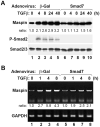Convergence of p53 and transforming growth factor beta (TGFbeta) signaling on activating expression of the tumor suppressor gene maspin in mammary epithelial cells
- PMID: 17204482
- PMCID: PMC4015524
- DOI: 10.1074/jbc.M608499200
Convergence of p53 and transforming growth factor beta (TGFbeta) signaling on activating expression of the tumor suppressor gene maspin in mammary epithelial cells
Abstract
Using two-dimensional difference gel electrophoresis, we identified the tumor suppressor gene maspin as a transforming growth factor beta (TGFbeta) target gene in human mammary epithelial cells. TGFbeta up-regulatesMaspin expression both at the RNA and protein levels. This up-regulation required Smad2/3 function and intact p53-binding elements in the Maspin promoter. DNA affinity immunoblot and chromatin immunoprecipitation revealed the presence of both Smads and p53 at the Maspin promoter in TGFbeta-treated cells, suggesting that both transcription factors cooperate to induce Maspin transcription. TGFbeta did not activate Maspin-luciferase reporter in p53-mutant MDA-MB-231 breast cancer cells, which exhibit methylation of the endogenous Maspin promoter. Expression of ectopic p53, however, restored ligand-induced association of Smad2/3 with a transfected Maspin promoter. Stable transfection of Maspin inhibited basal and TGFbeta-stimulated MDA-MB-231 cell motility. Finally, knockdown of endogenous Maspin in p53 wild-type MCF10A/HER2 cells enhanced basal and TGFbeta-stimulated motility. Taken together, these data support cooperation between the p53 and TGFbeta tumor suppressor pathways in the induction of Maspin expression, thus leading to inhibition of cell migration.
Figures






Similar articles
-
TAp63gamma can substitute for p53 in inducing expression of the maspin tumor suppressor.Int J Cancer. 2005 Apr 20;114(4):555-62. doi: 10.1002/ijc.20766. Int J Cancer. 2005. PMID: 15578720
-
Histone modifications affect differential regulation of TGFβ- induced NADPH oxidase 4 (NOX4) by wild-type and mutant p53.Oncotarget. 2017 Jul 4;8(27):44379-44397. doi: 10.18632/oncotarget.17892. Oncotarget. 2017. PMID: 28574838 Free PMC article.
-
Snail transcription factor negatively regulates maspin tumor suppressor in human prostate cancer cells.BMC Cancer. 2012 Aug 2;12:336. doi: 10.1186/1471-2407-12-336. BMC Cancer. 2012. PMID: 22857708 Free PMC article.
-
Tumor suppressor maspin as a rheostat in HDAC regulation to achieve the fine-tuning of epithelial homeostasis.Crit Rev Eukaryot Gene Expr. 2012;22(3):249-58. doi: 10.1615/critreveukargeneexpr.v22.i3.80. Crit Rev Eukaryot Gene Expr. 2012. PMID: 23140166 Free PMC article. Review.
-
Maspin--a novel protease inhibitor with tumor-suppressing activity in breast cancer.Acta Oncol. 2000;39(8):931-4. doi: 10.1080/02841860050215909. Acta Oncol. 2000. PMID: 11206999 Review.
Cited by
-
Identification of phosphorylation sites on extracellular corneal epithelial cell maspin.Proteomics. 2011 Apr;11(8):1382-90. doi: 10.1002/pmic.201000362. Epub 2011 Mar 1. Proteomics. 2011. PMID: 21365746 Free PMC article.
-
Transforming growth factor-β regulates the sphere-initiating stem cell-like feature in breast cancer through miRNA-181 and ATM.Oncogene. 2011 Mar 24;30(12):1470-80. doi: 10.1038/onc.2010.531. Epub 2010 Nov 22. Oncogene. 2011. PMID: 21102523 Free PMC article.
-
Murine microenvironment metaprofiles associate with human cancer etiology and intrinsic subtypes.Clin Cancer Res. 2013 Mar 15;19(6):1353-62. doi: 10.1158/1078-0432.CCR-12-3554. Epub 2013 Jan 21. Clin Cancer Res. 2013. PMID: 23339125 Free PMC article.
-
TGF-β mediated DNA methylation in prostate cancer.Transl Androl Urol. 2012 Jun;1(2):78-88. doi: 10.3978/j.issn.2223-4683.2012.05.06. Transl Androl Urol. 2012. PMID: 25133096 Free PMC article.
-
Integrating the tumor-suppressive activity of Maspin with p53 in retuning the epithelial homeostasis: A working hypothesis and applicable prospects.Front Oncol. 2022 Nov 29;12:1037794. doi: 10.3389/fonc.2022.1037794. eCollection 2022. Front Oncol. 2022. PMID: 36523976 Free PMC article. Review.
References
-
- Massague J, Blain SW, Lo RS. Cell. 2000;103(2):295–309. - PubMed
-
- Siegel PM, Massague J. Nat Rev Cancer. 2003;3(11):807–820. - PubMed
-
- Wakefield LM, Roberts AB. Curr Opin Genet Dev. 2002;12(1):22–29. - PubMed
-
- Massague J, Seoane J, Wotton D. Genes Dev. 2005;19(23):2783–2810. - PubMed
-
- Arteaga CL. Curr Opin Genet Dev. 2006;16(1):30–37. - PubMed
Publication types
MeSH terms
Substances
Grants and funding
LinkOut - more resources
Full Text Sources
Research Materials
Miscellaneous

